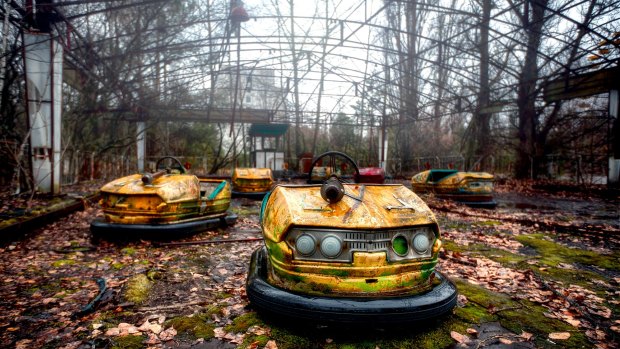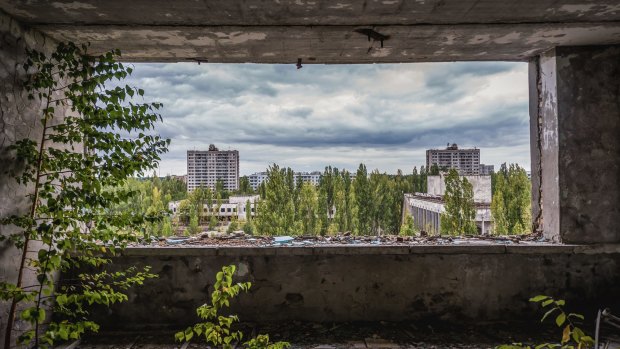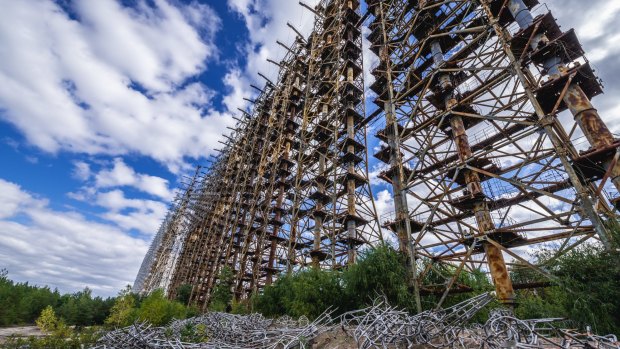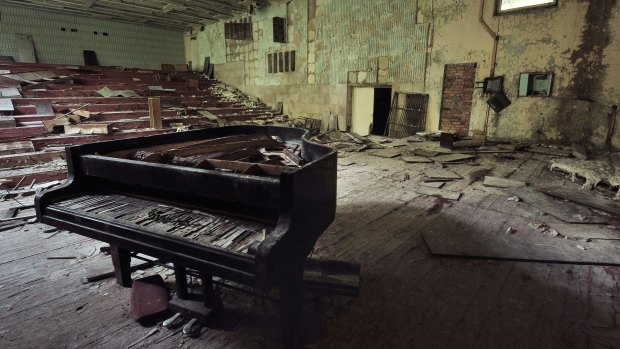This was published 5 years ago
Chernobyl, Ukraine: What it's like to stay at the Chernobyl Exclusion Zone
By Tim Richards
As I bend over the abandoned doll, the reading on my dosimeter begins to tick upward. At a certain level, this portable radiation detector will squeal. It's hard not to feel uneasy at the rising numbers on its face. For this is Chernobyl. Or to be precise, the 30-kilometre-wide Chernobyl Exclusion Zone around the reactor that exploded in 1986, spewing radioactive material into the air to become the world's worst nuclear disaster.
I'm standing in Kopachi, one of many abandoned villages. Along with two cities, Chernobyl and Pripyat, they form a ghostly collection of modern ruins in northern Ukraine.
With four other visitors, I'll be sleeping over in the zone tonight. Our host is Chernobyl Tour, founded by Sergii Mirnyi, a former emergency worker who took part in the post-disaster clean-up.

An abandoned collection of dodgem cars sprouting weeds in Chernobyl.Credit: SHUTTERSTOCK
One of our first stops is Kopachi's ruined kindergarten, its collapsing interiors strewn with paper and toys, a doll embedded in the front garden, missing most of its limbs.
Our guide, Alex, points out the radiation level is higher in the soil by the path than on the path itself.
"You can clean asphalt, but it's not easy to clean soil," he says.

Inside the hotel in abandoned Pripyat city in Chernobyl Exclusion Zone, Ukraine.Credit: Shutterstock.com
Radiation exposure is also a matter of time. By the end of our 30-hour tour the company estimates we'll have received a radiation dose of just 0.004 millisieverts, comparable to that received in any city.
To be allowed into the zone, two hours north of Kiev, tour members have to wear long-sleeved shirts and closed shoes. And we've been sternly warned not to wander off paths, and not to eat the local mushrooms.
A second checkpoint gives access to the inner exclusion zone, just 10 kilometres from the reactor site.

Former military Duga radar system in Chernobyl Exclusion Zone, Ukraine.Credit: Shutterstock
Alex mentions there are few animals within this inner area, though we see some stray dogs which hang around military posts and are fed by soldiers. As for other inhabitants, we never meet any of the "self-settlers", the few hundred people who've moved back illegally into the exclusion zone. Understandably, they're wary of outsiders.
The most startling location in the inner zone is Pripyat, built in the 1970s to serve as a dormitory city for workers at the adjacent nuclear complex.
From the overgrown main plaza with its former hotel and cultural centre, we walk through the deserted city with Alex.

Ruined grand piano in a concert hall in Pripyat in the Chernobyl Exclusion Zone.Credit: Shutterstock
There's no denying the eeriness of this place. The day after the calamity its residents were evacuated, assuming they'd return when the crisis was over. They never did. The sudden abandonment, along with later looting, has created a uniquely unsettling cityscape.
Alex leads us from the cultural centre to the amusement park beyond. A Ferris wheel is here, near a set of dodgem cars sprouting weeds. Then it's a short stroll through a stand of young trees to a dilapidated sports stadium. The basketball court's floor is shredded, and the pool's diving board hangs above an empty basin scattered with debris.
Before we pass back to the outer zone, we have to stand within screening devices that check for radioactive traces.
Our night is spent at a Soviet-era hotel with basic rooms and shared bathrooms. Catering is included, a simple affair of fixed courses; though our Russian-speaking driver jokes about having picked some local mushrooms for my meal.
Dark humour aside, there's no lack of fascinating sights within the zone. On the second day we head along a decaying concrete road to the remains of Duga-1, a huge and once top-secret radar installation that scanned for incoming nuclear missiles. It creaks in the wind as if haunted, an unnerving sound in the deserted forest.
The highlight of the tour comes at the end of the day as we stand a short distance from the former Reactor 4, which exploded more than three decades ago and cost so many lives.
This isn't comfortable tourism, and is far removed from conventional European excursions to charming villages and romantic castles. It is, however, a powerful insight into a terrifying instance of technology gone wrong. A dark story, but a valuable one.
Tim Richards was a guest of by Chernobyl Tour.
Emirates and its partners connect to Kiev via Dubai. See emirates.com.
TOUR
The two-day Chernobyl tour starts from Kiev and costs US$304 per person. Book via chernobyl-tour.com
See also: Off limits: Nine places where independent travellers are banned
See also: It's fake: The shocking truth behind world-famous attractions
Sign up for the Traveller Deals newsletter
Get exclusive travel deals delivered straight to your inbox. Sign up now.